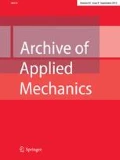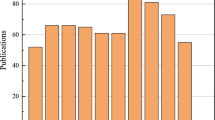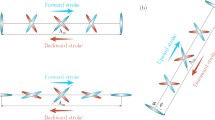Abstract
In the recent decades, biomimetic robots have attracted scientific communities’ attention increasingly, as people try to learn from nature in which exist astonishing and uniquely evolved mechanisms shown by very species. Dragonfly, as such one example, demonstrates unique and superior flight performance than most of the other insect species and birds. Researchers are obsessed with the aerodynamic characteristics of an in-flight dragonfly as two pairs of independently controlled wings provide them with an unmatchable flying performance and robustness. In this paper, an extensive review of recent studies related to the flight aerodynamics of dragonflies has been conducted. The main research findings about effect of the motion parameters and body attitude on the resulting aerodynamic forces and power requirements in different flight modes of a dragonfly are summarized. Particular attention is given to functional characteristics of dragonfly wings and the importance of mutual interaction between forewing and hindwing for its flyability. This article aims to bring together current understandings of dragonfly aerodynamics and thus has certain reference value to design and control of dragonfly-inspired biomimetic devices.














































Similar content being viewed by others
References
Ellington, C.P.: The novel aerodynamics of insect flight: applications to micro-air vehicles. J. Exp. Biol 202, 3439–3448 (1999)
Obata, A., Shinohara, S., Akimoto, K., Suzuki, K., Seki, M.: Aerodynamic bio-mimetics of gliding dragonflies for ultra-light flying robot. Robotics 3, 163–180 (2014)
Couceiro, M.S., Fonseca Ferreira, N.M., Tenreiro Machado, J.A.: Analysis and control of a dragonfly-inspired robot. In: International Symposium on Computational Intelligence for Engineering Systems, Porto, pp. 18–19 (2009)
Couceiro, M.S., Fonseca Ferreira, N.M., Tenreiro Machado, J.A.: Hybrid adaptive control of a dragonfly model. Commun. Nonlinear Sci. Numer. Simul. 17, 893–903 (2012)
Hu, Z., Deng, X.Y.: A flight strategy for intelligent aerial vehicles learned from dragonfly. In: Lam, T.M. (ed.) Aerial Vehicles, pp. 189–202. InTech, Rijeka (2009)
Gaissert, N., Mugrauer, R., Mugrauer, G., Jebens, A., Jebens, K., Knubben, E.M.: Inventing a micro aerial vehicle inspired by the mechanics of dragonfly flight. In: Natraj, A., Cameron, S., Melhuish, C., Witkowski, M. (eds.) Towards Autonomous Robotic Systems, pp. 90–100. Springer, Berlin (2014)
Azuma, A., Azuma, S., Watanabe, I., Furuta, T.: Flight mechanics of a dragonfly. J. Exp. Biol. 116, 79–107 (1985)
Azuma, A., Watanabe, T.: Flight performance of a dragonfly. J. Exp. Biol. 137, 221–252 (1988)
May, M.L.: Dragonfly flight: power requirement at high speed and acceleration. J. Exp. Biol. 158, 325–342 (1991)
Wakeling, J.M., Ellington, C.P.: Dragonfly flight. I. Gliding flight and steady-state aerodynamic forces. J. Exp. Biol. 200, 543–556 (1997)
Wakeling, J.M., Ellington, C.P.: Dragonfly flight. II. Velocities, accelerations and kinematics of flapping flight. J. Exp. Biol. 200, 557–582 (1997)
Wakeling, J.M., Ellington, C.P.: Dragonfly flight. III. Lift and power requirements. J. Exp. Biol. 200, 583–600 (1997)
Alexander, D.E.: Wind tunnel studies of turns by flying dragonflies. J. Exp. Biol. 122, 81–98 (1986)
Alexander, D.E.: Unusual phase relationships between the forewings and hindwings in flying dragonflies. J. Exp. Biol. 109, 379–383 (1984)
Alexander, D.E.: Studies on flight control and aerodynamics in dragonflies. 1982, PhD Dissertation, Duke University
Freymuth, P.: Thrust generation by an airfoil in hover modes. Exp. Fluids 9, 17–24 (1990)
Chadwick, L.E.: The wing motion of the dragonfly. Bull. Brooklyn Ent. So. 35, 109–112 (1940)
Neville, A.C.: Aspects of flight mechanics in anisopterous dragonflies. J. Exp. Biol. 37, 631–656 (1960)
Newman, B.G., Savage, S.B., Schouella, D.: Model tests on a wing section of an Aeschna dragonfly. In: Pendley, T.J. (ed.) Scale Effects in Animal Locomotion, pp. 445–477. Academic Press, New York (1977)
Norberg, R.A.: Hovering flight of the dragonfly Aeschna juncea L., kinematics and aerodynamics. In: Wu, Y.T., Brokaw, C.J., Brennen, C. (eds.) Swimming and Flying in Nature, vol. 2, pp. 763–781. Plenum Press, New York (1975)
Russell, D.B.: Numerical and experimental investigations into the aerodynamics of dragonfly flight. Cornell University, New York Thesis (Ph.D.), (August, 2004)
Wang, Z.J., Russell, D.B.: Effect of forewing and hindwing interactions on aerodynamic forces and power in hovering dragonfly flight. Theoret. Appl. Mech. 148101, 1–4 (2007)
Thomas, A.L., Taylor, G.K., Srygley, R.B., Nudds, R.L., Bomphrey, R.J.: Dragonfly flight: free-flight and tethered flow visualizations reveal a diverse array of unsteady lift-generating mechanisms, controlled primarily via angle of attack. J. Exp. Biol. 207, 4299–4323 (2004)
Wang, Z.J.: Vortex shedding and frequency selection in flapping flight. J. Fluid Mech. 410, 323–341 (2000)
Wang, Z.J.: Two dimensional mechanism for insect hovering. Phys. Rev. Lett. 85, 2035–2038 (2000)
Wang, Z.J., Birch, J.M., Dickinson, M.H.: Unsteady forces and flows in low Reynolds number hovering flight: two dimensional computations vs robotic wing experiments. J. Exp. Biol. 207, 449–460 (2004)
Wu, J.H., Sun, M.: Unsteady aerodynamic forces of a flapping wing. J. Exp. Biol. 207, 1137–1150 (2004)
Sun, M., Hamdani, H.: A study on the mechanism of high-lift generation by an airfoil in unsteady motion at low Reynolds number. Acta Mech. Sin. 17, 97–114 (2001)
Mou, X.L., Sun, M.: Effects of wing planform on aerodynamic force production of stroking model insect wing. J. Beijing Univ. Aeronaut. Astronaut. 37, 1359–1364 (2011)
Lan, S., Sun, M.: Aerodynamic properties of a wing performing unsteady rotational motion at low Reynolds number. Acta Mech. 149, 145–147 (2001)
Lan, S., Sun, M.: Aerodynamic force and flow structures of two airfoils in flapping motions. Acta Mech. Sin. 17, 310–331 (2001)
Lehmann, F.O.: Wing–wake interaction reduces power consumption in insect tandem wings. Exp. Fluids 46, 765–775 (2009)
Gustafson, K., Leben, R.: Computation of dragonfly aerodynamics. Comput. Phys. Commun. 65, 121–132 (1991)
Resh, V.H., Cardé, R.T.: Encyclopedia of Insects. Academic Press, San Diego (2009)
Berman, G., Wang, Z.J.: Energy-minimizing kinematics in hovering insect flight. J. Fluid Mech. 582, 153–168 (2007)
Lu, Y., Shen, G.X., Lai, G.J.: Dual leading-edge vortices on flapping wings. J. Exp. Biol. 209, 5005–5016 (2006)
Premachandran, S., Giacobello, M.: The effect of wing corrugations on the aerodynamic performance of low-Reynolds number flapping flight. In: \(17^{\rm th}\) Australasian Fluid Mechanics Conference. Auckland, New Zealand. 5–9 December, 2010
Sudhakar, Y., Vengadesan, S.: Flight force production by flapping insect wings in inclined stroke plane kinematics. Comput. Fluids. 39, 683–695 (2010)
Wang, Z.J.: Dissecting insect flight. Ann. Rev. Fluid Mech. 37, 183–210 (2005)
Wang, H., Zeng, L.J., Liu, H., Yin, C.Y.: Measuring wing kinematics, flight trajectory and body attitude during forward flight and turning maneuvers in dragonflies. J. Exp. Biol. 206, 745–757 (2003)
Lai, G.J., Shen, G.X.: Experimental investigation on the wing–wake interaction at the mid stroke in hovering flight of dragonfly. Sci. China Phys. Mech. Astron. 55, 2167–2178 (2012)
Wang, J.K., Sun, M.: A computational study of the aerodynamics and forewing–hindwing interaction of a model dragonfly in forward flight. J. Exp. Biol. 208, 3785–3804 (2005)
Sane, S.P.: The aerodynamics of insect flight. J. Exp. Biol. 206, 4191–4208 (2003)
Shyy, W., Trizila, P., Kang, C., Aono, H.: Can tip vortices enhance lift of a flapping wing? Aerosp. Lett. 47, 289–293 (2009)
Hefler, C., Qiu, H., Shyy, W.: The interaction of wings in different flight modes of a dragonfly. \(17^{\rm th}\) International Symposium on Application of Laser Techniques to Fluid Mechanics. Lisbon, Portugal (07–10 July, 2014)
Alexander, D.E.: Unusual phase relationships between the forewings and hindwings in flying dragonflies. J. Exp. Biol. 109, 379–383 (1984)
Newman, B.G., Savage, S.B., Schouella, D.: Model test on a wing section of an Aeschna dragonfly. In: Pedley, T.J. (ed.) Scale Effects in Animal Locomotion, pp. 445–477. Academic Press, London (1977)
Biewener, A.B.: Animal Locomotion. Oxford University Press, Oxford (2003)
Hankin, E.H.: The soaring flight of dragonflies. Proc. Camb. Philos. Soc. 20, 460–465 (1921)
Polcyn, D.M.: The thermal biology of desert dragonflies. University of California, USA. Thesis (Ph.D.) (1988)
Corbet, P.S.: A Biology of Dragonflies. Classey, Farringdon (1983)
May, M.L.: Dependence of flight behavior and heat production on air temperature in the green darner dragonfly, Anax junius (Odonata: Aeshnidae). J. Exp. Biol. 198, 2385–2392 (1995)
Zhang, J., Lu, X.Y.: Aerodynamic performance due to forewing and hindwing interaction in gliding dragonfly flight. Phys. Rev. E 80, 017302 (2009)
Xiao, T.H.: A numerical method for unsteady low Reynolds number flows and application to Micro Air Vehicles. Nanjing University of Aeronautics and Astronautics, China, Thesis (Ph.D.) (April, 2009) (in Chinese)
Xiao, T.H., Ang, H.S.: Numerical study of unusual phase relationships and aerodynamic interaction between forewing and hindwing of dragonfly model. Acta Aeronaut. ET Astronaut. Sin. 30, 1165–1175 (2009). (in Chinese)
Maybury, W.J., Lehmann, F.O.: The fluid dynamics of flight control by kinematic phase lag variation between two robotic insect wings. J. Exp. Biol. 207, 4707–4726 (2004)
DiLeo, C., Deng, X.Y.: Design and experiments of a dragonfly-inspired robot. Adv. Robot. 23, 1003–1021 (2009)
Guo, T.: Design and prototype of a hovering ornithopter based on dragonfly flight. Massachusetts Institute of Technology, USA. Bachelor’s Thesis. (June, 2007)
Hu, Z., Deng, X.Y.: Aerodynamic effect of forewing–hindwing interactions in hovering and forward flight of dragonfly. In: Proceeding of the Annual Meeting of the Society for Integrative and Comparative Biology (SICB’09), Boston, USA (January, 2009)
Naidu, V., Young, J., Lai, J.C.S.: Effect of wing flexibility on dragonfly hover flight. In: \(19{\rm th}\) Australasian Fluid Mechanics Conference, Melbourne, Australia (December, 2014)
Hu, Z., McCauley, R., Schaeffer, S., Deng, X.: Aerodynamics of dragonfly flight and robotic design. In: Proceedings of the 2009 IEEE International Conference on Robotics and Automation, Kobe, Japan (May, 2009)
Ellington, C.P., Vandenberg, C., Willmott, A.P., Thomas, A.L.R.: Leading-edge vortices in insect flight. Nature 384, 626–630 (1996)
Xie, C.M., Huang, W.X.: Vortex interactions between forewing and hindwing of dragonfly in hovering flight. Theoret. Appl. Mech. Lett. 5, 24–29 (2015)
Hu, Z., Deng, X.Y.: Aerodynamic interaction between forewing and hindwing of a hovering dragonfly. Acta Mech. Sin. 30, 787–799 (2014)
Sun, M., Lan, S.L.: A computational study of the aerodynamic forces and power requirements of dragonfly Aeschna juncea hovering. J. Exp. Biol. 207, 1887–1901 (2004)
Sun, M., Tang, J.: Lift and power requirements of hovering flight in Drosophila virilis. J. Exp. Biol. 205, 2413–2427 (2002)
Dokkum, P.V.: Dragonflies: Magnificent Creatures of Water, Air and Land. Yale University Press, New Haven (2015)
Berger, C.: Dragonflies. Stackpole Books, Mechanicsburg (2004)
Xu, J.L., Zhao, C.X., Zhang, Y.L., Zhang, Y.: Effect of flapping trajectories on the dragonfly aerodynamics. Chin. Sci. Bull. 51, 777–784 (2006)
Jongerius, S.R., Lentink, D.: Structural analysis of a dragonfly wing. Exp. Mech. 50, 1323–1334 (2010)
Chen, Y.H., Skote, M., Zhao, Y., Huang, W.M.: Stiffness evaluation of the leading edge of the dragonfly wing via laser vibrometer. Mater. Lett. 97, 166–168 (2013)
Xu, M., Yu, Y.L., Bao, L.: Theoretical modeling study on the aerodynamic effects of dragonfly flexible wing in forward flapping flight. J. Grad. Sch. Chin. Acad. Sci. 23, 729–735 (2006). (in Chinese)
Meng, L.B., Ang, H.S., Xiao, T.H.: Analysis of aerodynamic characteristics of flexible wing of dragonfly based on CFD/CSD method. J. Aerosp. Power 29, 2063–2069 (2014). (in Chinese)
Nakata, T., Liu, H.: Aerodynamic performance of a hovering hawkmoth with flexible wings: a computational approach. Proce. R. Soc. B 279, 722–731 (2011)
Vargas, A., Mittal, R., Dong, H.B.: A computational study of the aerodynamic performance of a dragonfly wing section in gliding flight. Bioinspir. Biomim. 3, 026004 (2008)
Acknowledgements
This work was supported by National Natural Science Foundation of China Grant (Nos. 50836006, 11202123 and 51376096).
Author information
Authors and Affiliations
Corresponding author
Rights and permissions
About this article
Cite this article
Sun, X., Gong, X. & Huang, D. A review on studies of the aerodynamics of different types of maneuvers in dragonflies. Arch Appl Mech 87, 521–554 (2017). https://doi.org/10.1007/s00419-016-1208-7
Received:
Accepted:
Published:
Issue Date:
DOI: https://doi.org/10.1007/s00419-016-1208-7




